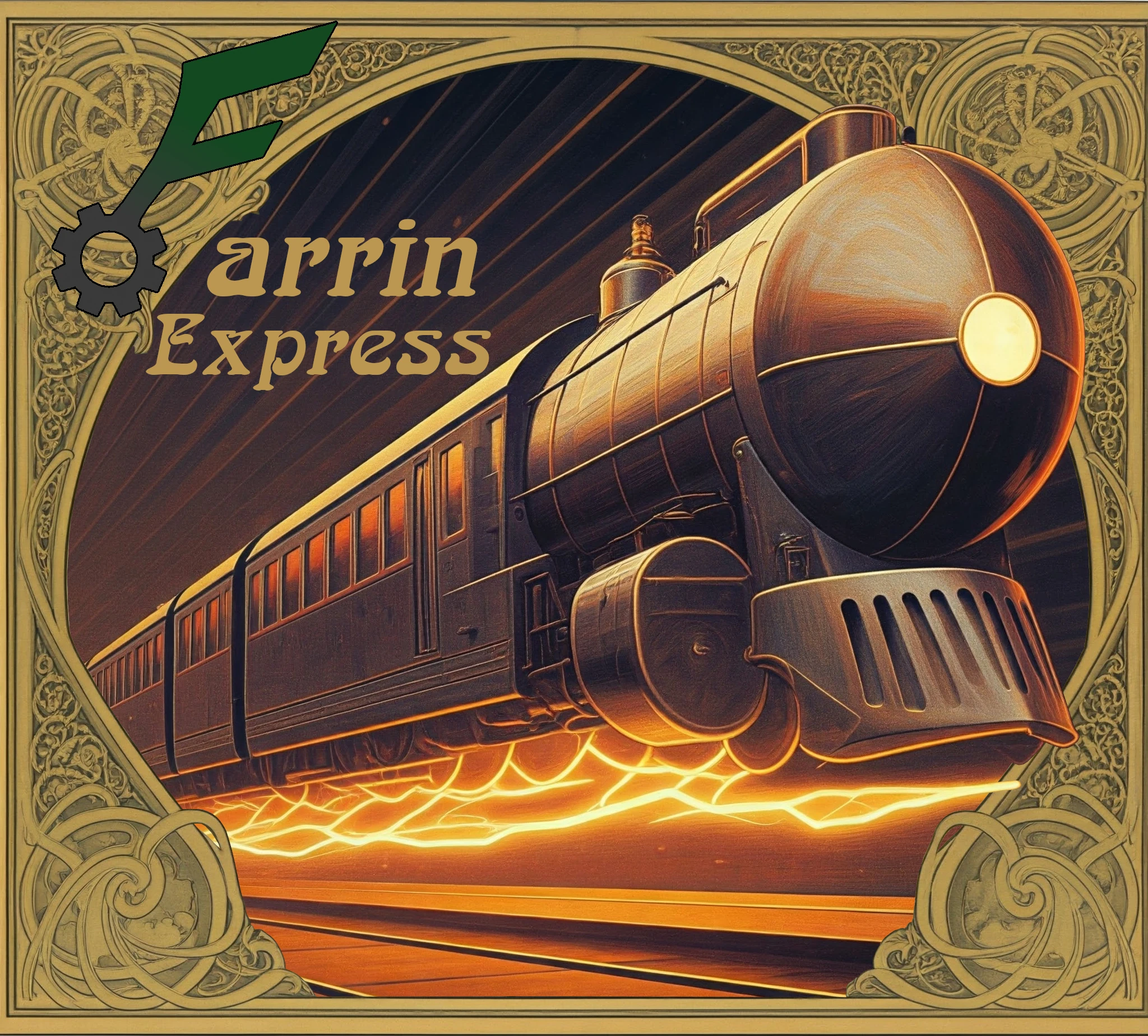Farrin Express
The Farrin Express is a train designed and engineered by Farrin Enterprises.
The original Farrin Express line runs eastward from NRC's Wellmore Station, to Cheesequake, to Cragport. More recently, the first segment of a westward line was completed. It runs from NRC, through the Genfreet Mountain Range, and ends at Varn. Construction of other interconnecting lines are underway but currently there is only one commercially accessible.
Travel
Tickets to travel along the Farrin Express are calculated at roughly 4 cp per mile.
Public OpinionEastern Route: NRC ↔ Cragport
- Full route
- Distance: ~1,354 miles
- Travel time: ~84 hours (~3.5 days)
- Ticket Price (full route): 54 gp, 1 sp, 6 cp
- Half route (to/from Cheesequake or stopping in Cheesequake)
- Distance: ~677 miles
- Travel time: ~42 hours (~1.75 days)
- Ticket Price (full route): 27 gp, 0 sp, 8 cp
Western Route: NRC ↔ Varn
Travels from NRC, into the Farrin-Reddingten Tunnel through the Genfreet Mountains, then out through the savanna to Varn.
- Distance: ~1,272 miles
- Travel time: ~79.5 hours (~3.3 days)
- Ticket Price: 50 gp, 8 sp, 8 cp
Cars
Each standard car is ~90 feet long, with a 5 foot gap between cars (~18 squares, with 1 latch at either end sharing a square with the next car’s latch). The engine and tender car (maintenance/fuel cabin for the engine) make up a another ~60 feet (~12 squares), with the rest of the engine continuing another 60 feet further, making up ~80 feet total (~16 squares) by itself. The rear carriage of the train is only ~40 feet long (~8 squares) with a 15x ft long, 20 ft wide (3x4 squares) balcony hanging off of the back.
The most common configuration is:
- Engine
- Tender car
- Kitchen car
- Dining car
- Passenger car - sleeper
- Passenger car - sleeper
- Passenger car - sleeper
- VIP car
- Cargo car
- Cargo car
- Rear carriage
Dining Car
The dining car is outfitted with a full bar/cafe and seated tables, as well as some spots with stools bolted to the floor. Food can be brought elsewhere, but only ordered from the bar. The menus provided are short due to the limited stock aboard the train, but some items rotate periodically or seasonally to keep it interesting. Breakfast and one dinner item per day, as well as water and juice, are complimentary with the ticket. Anything beyond these cost an additional fee.
Sample menu
| Breakfast | Lunch | Dinner (served with a side salad or fries) | Snacks | Beverages |
|---|---|---|---|---|
| - eggs any style - crab meat hash - pancakes - waffles - assorted fruit - moolette yogurt with nuts | - tuna sandwich - mudcrab sandwich with butter or mayo - fall salad | - beef meatballs with butter pasta - seasonal stew - clams casino | - crackers - cheese - hummus - white fish - dip | - water - apple juice - grape juice - milk - mead - beer - wine |
Power Generation
The Farrin Express is powered by a highly efficient magical capacitance crystal, charged via proprietary means by Farrin Enterprises. The crystal is housed in specially engineered machinery, tuned to output a steady rate of arcane electricity. Controls and systems on the machine allow an engineer to monitor as well as reduce, amplify, or fine tune the crystal's output in other ways.
Propulsion
The electricity output from the train's crystal is transmitted to the engine car, which focuses the energy down into a network of connected, specifically angled panels on the underside of the train. The charge in these panels is used to generate a repulsive force at desired angles. When activated, these panels can, in tandem with the panels built into the lightning rail line, allow the train to hover and propel itself in a direction.



